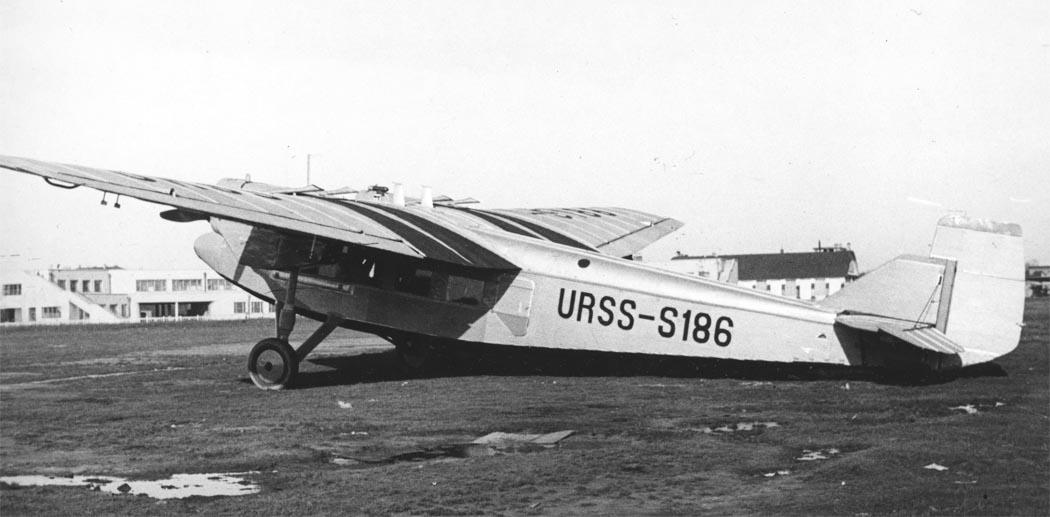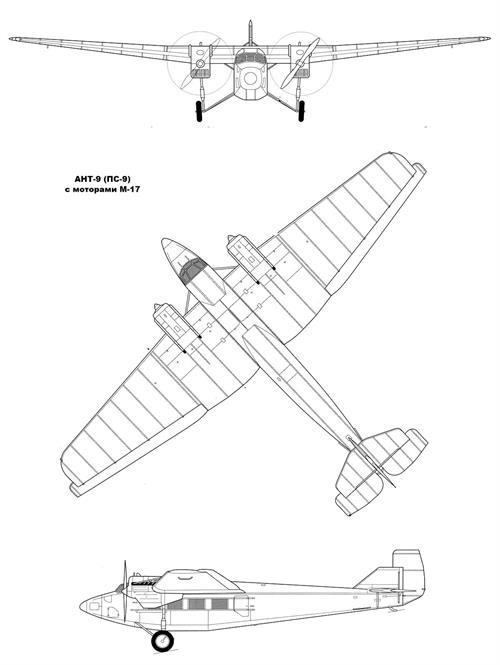| Type |
Werk.Nr |
Registration |
History |
|
145 |
D-2831 |
DeruLuft, Berlin |
| Type |
2-seat transport plane |
| Engine |
2 Klimov M-17 |
| Dimensions |
Length 17,01 m, height 4,86 m , span 27,31 m , wing area 84,0 m2 , |
| Weights |
Empty 4400 kg, loaded 6200 kg , max. take off weight load 1700 kg |
| Performance |
Max.. speed 215 km/h , cruising speed 192 km/h , range 700 km, endurance , service ceiling 5100 m , climb |



The Tupolev ANT-9 (Russian: Туполев АНТ-9) was a Soviet passenger aircraft of the 1930s. It was developed as a reaction to the demand for a domestic airliner. At this time Deruluft, one of the forerunners of Aeroflot, flew only with foreign models, which were mainly German or Dutch.
Design work began in December 1927. The first prototype, named Krylia Sovietov (Wings of the Soviets) used three French Gnome-Rhone Titan radial engines. It was presented to the public on 1 May 1929 at Red Square and it went to the national flight testing, which was completed in June. In the first series 12 aircraft were built. In production, the Titan engines were replaced with M-26 engines, but these proved too unreliable and were replaced with imported Wright Whirlwind engines. Two of these airplanes were used by Deruluft, starting from 1933 on the Berlin-Moscow service. Mikhail Gromov accomplished a European round on the route Moscow – Travemünde – Berlin – Paris – Rome flight – Marseille – London – Paris – Berlin – Warsaw – Moscow with the Krylia Sovietov, which lasted from 10 July to 8 August 1929 and generated considerable publicity. It carried eight passengers over a distance of 9,037 km , in 53 flying hours with an average speed of 177 km/h..
In September 1930, testing of the Wright-powered version of the ANT-9 was completed. A few were used as executive transports for the Soviet Air Forces. A military variant with standard and retractable turrets was under construction, but was abandoned before trials began. An ambulance version was studied and considered, but never built. In 1932, GVF engineer Sergei Ivanovich Komarov proposed a modification of the ANT-9 wing to accommodate two M-17 engines, similar to what was done on the R-6. Production began in 1933 as the PS-9 (Russian: пассажирский самолёт, romanized: passazhirskiy samolot, passenger airplane). The number of aircraft built amounted to about 70 machines. Up to the beginning of the German invasion of the Soviet Union, they served as passenger or staff airplanes mainly on routes in Central Asia and the Caucasus. Afterwards they were used until 1943 as transportation and medical airplanes. One PS-9 was modified into a propaganda aircraft named Krokodil (Crocodile) with a reptile-like plywood nose.




